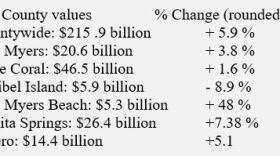The Everglades restoration is among the largest aquatic restoration efforts to ever occur, with dozens of projects spanning 18,000 square miles from Orlando to Biscayne Bay, and from Florida Bay to the Caloosahatchee River.
Dozens of the projects were discussed in sessions at the year’s Everglades Coalition annual gathering, which brought together the more than 50 nonprofits working toward a restored River of Grass. The weekend of panels focused on completed projects, lessons learned, and what else still needs to be accomplished.
But one session stood out from the others at the Hyatt Regency Coconut Point Resort & Spa in Bonita Springs this past weekend, and it wasn't because the project being addressed was the largest in scope or the most expensive.
While each discussion was about a different place, the mechanics of each project sounded similar, which made sense because the restorations are all about moving the right amount of clean water to the right spot at the right time: pumps to be built, ponds to be dug, reservoirs to be constructed, and wetlands to be restored.
And each member of the panels started looking the same, a blend of successful nonprofit leaders and government engineering types. Just like the year before.
Except for the panel early Saturday that discussed the Western Everglades Restoration, which featured something no other session did: a leader of the Miccosukee Tribe of Indians of Florida sitting next to a leader of the Seminole Tribe of Florida.
The Western Everglades is not only the backyard of everyone who lives along the coast of Southwest Florida. It also includes the areas with the Big Cypress National Preserve that include Native American reservations.
"Last year, what I asked all of you to do was to put Native voices at the center of Everglades restoration. And you did that,” said Curtis Osceola, chief of staff of the Miccosukee Tribe of Indians of Florida. “And I wanted to say thank you all for hearing us out, and for listening to our message, and for empowering us to lead the charge on Everglades restoration.”
Sitting next to him was Tina Marie Osceola of the Seminole Tribe of Florida, who is the interim executive director of operations and the Tribal Historic Preservation Office.
Curtis Osceola is Tina Marie Osceola’s nephew. They joked about not being sure how they ended up being so closely related but in separate tribes.
They didn’t joke about their Tribes’ upcoming roles in the Everglades restoration, nor it being something that should have occurred long ago.
Tina Marie Osceola called it a “milestone.”
“We have to take a step back and understand this is about legacy,” she said. “What we do with the state today will matter in 100 years when none of us will be here.”
The relationship between the Miccosukee and Seminole tribes of Florida is complex. Despite being rooted in shared history and culture, at times the tribes have moved in different paths.
The Seminole Tribe received federal recognition in 1957, and the Miccosukee Tribe of followed with their own recognition in 1962. Although closely related in cultural and historical terms, the two tribes have pursued separate sovereign rights and have developed their own governance structures, economic enterprises, and social programs.
There have also been moments of disagreement and differing priorities in environmental and economic matters, differences based on the specific interests and the needs of its members.
At other times there have been collaboration and shared interests when it comes to preservation of their cultural heritage and rights to land and natural resources in Florida.
And that was on display again, perhaps publicly for the first time in decades, on Saturday morning.
Saturday evening the three-day conference was winding down. All the panels were done. Several dozen exhibition booths that had been set up all weekend, offering free pens or bags or bumper stickers for a few seconds listening to the person at the table explain his or her cause, were empty.
Most of the more than 400 people who make up the Everglades Coalition were in the big conference room, ready to listen to Rep. Debbie Wasserman Shultz (D-FL), co-chair of the Everglades Caucus, a bipartisan group in Congress that works to secure funding for the restoration.
She had several points to make about the importance of restoring the Everglades, but her most poignant message was to the people sitting in front of her.
“This is literally the one event I make sure I go to every single year,” Wasserman Shultz said. “It never ceases to amaze me, and impress me, this room is always full, and it's always full because this is the most effective environmental coalition anywhere in the country.”
Environmental reporting for WGCU is funded in part by VoLo Foundation, a non-profit with a mission to accelerate change and global impact by supporting science-based climate solutions, enhancing education, and improving health.
Sign up for WGCU's monthly environmental newsletter, the Green Flash, today.
WGCU is your trusted source for news and information in Southwest Florida. We are a nonprofit public service, and your support is more critical than ever. Keep public media strong and donate now. Thank you.








